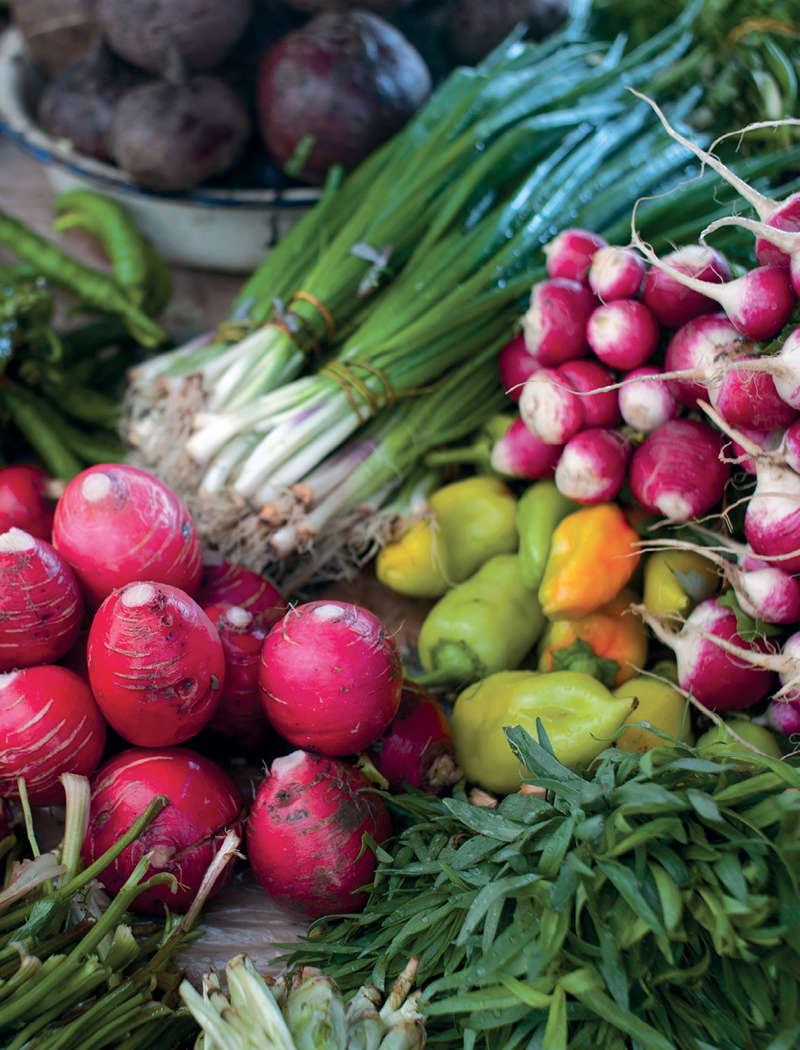

Tbilisi, Georgia—Stacks of vegetables and herbs in Deserteri Market in Georgia’s capital.
The simple chopped salads in the Persian culinary sphere are a real pleasure. Made with cucumbers, tomatoes, or onions, or a combination, they’re light and refreshing, dressed not with oil but instead with a drizzle of pomegranate syrup or a little vinegar, and sprinkled with herbs, salt, and perhaps sumac.
This chapter opens with a few of these raw salads, and then moves on to the delectable Persian dishes called borani (see recipes here and here), in which cooked vegetables are dressed with thick yogurt and fried onions. There’s a collection of eggplant dishes from all over the region; not only is eggplant versatile, it is also meaty and satisfying. The nut-rich aromatic Georgian vegetable pâtés called pkhali (see recipes here and here) are a real pleasure, as is the Armenian walnut and bean pâté (see recipe).
There are two other inviting bean dishes in this chapter, one a classic Georgian lobio (see recipe), made from red kidney beans, and the other a Kurdish white bean stew (see recipe). (You’ll find more bean and legume dishes in the Soup Paradise chapter.)
Cooks in the Persian culinary world have a repertoire of dishes that combine cooked vegetables with a little egg, a delicious pairing (see Azeri Mushrooms and Kurdish-Style Jerusalem Artichokes). The most sophisticated example of this kind of dish is the Persian kuku’ye sabzi, a kind of frittata that is loaded with greens and herbs.
Photograph here
In Kurdistan, the families I stayed with in Halabja and Sulaymaniyah would often put out a bowl of small tender-skinned Persian cucumbers when we were sitting around chatting. Alongside the bowl would be several small sharp knives so each person could peel and chop his or her own cucumbers as desired. It seemed so civilized to me, the cucumber refreshing, and the gestures a way of occupying your hands. Most people would peel the cucumber and then cut it lengthwise into long spears. And there was always salt for sprinkling on the cucumber pieces.
The fresh textures of this easy salad, inspired by that custom, are welcome with any meal.
Serves 4
About 2 cups ½-inch cubes peeled Persian or English cucumbers (see Note)
½ teaspoon dried mint
1 teaspoon ground sumac
¼ teaspoon sea salt, or to taste
Place the cucumbers in a serving bowl. Add the mint, sumac, and salt and toss. Taste and adjust the flavorings if you wish, toss again, and serve.
Note: If your cucumbers are overly mature, with tough seeds, halve them lengthwise and strip out the seeds before chopping.
If you have red or green ajika (see recipes here and here) on hand, the heat of the chile paste is a great pairing with the cool of the cucumber. Cut the cucumbers into spears or wedges; do not add salt, since the ajika is salty. I add a little water and a touch of oil to the ajika to make it more liquid, then either pour it onto the cucumbers and toss or put it out in a small bowl as a dip.
Photograph here
A lively Kurdish restaurant I visited between Arbil, the capital of Kurdistan, and its Assyrian suburb, Ainkawa, like many restaurants in Kurdistan, served families and women on the second floor and men alone on the ground floor. This was one of their salads, long spears of cucumber with a little chopped tomato and plenty of fresh herbs, drizzled with pomegranate molasses.
Serves 4
½ pound Persian or English cucumbers, peeled
1 large or 2 small Roma (plum) or other fleshy tomatoes
½ cup chopped fresh herbs: one or more of mint, sorrel, lovage, flat-leaf parsley, and/or leaf celery (see Glossary)
½ teaspoon salt, or to taste
About 2 tablespoons pomegranate molasses
Cut the cucumbers lengthwise in half, cut into 1½-inch lengths, and then cut into spears. Set aside in a shallow bowl.
Bring a small pot of water to a boil. Drop in the tomatoes, then use a large spoon to lift them out, let cool a moment, and peel. Chop the tomatoes into ¼-inch chunks.
Add the tomatoes to the cucumber, then add the herbs and toss to mix. Add the salt and toss. Add the pomegranate molasses and toss. Taste for seasoning and adjust the salt if you wish.
Attractive chopped salads are very common in Baku eateries, from hole-in-the-wall places to fancier restaurants. This one is a combination of cucumber, onion, and tomato tossed with fresh parsley and basil (usually dark red basil), a sprinkling of salt, and ground sumac.
Serves 4 to 6
½ pound ripe tomatoes, cut into ½-inch chunks
½ pound Persian or English cucumbers, peeled and cut into ½-inch chunks
Scant ½ cup thinly sliced mild onion (1 medium)
Several sprigs of fresh flat-leaf parsley
Several sprigs of fresh purple or green basil
2 tablespoons chopped fresh dill (optional)
About ½ teaspoon sea salt, or to taste
Generous sprinkling of ground sumac
Place the tomatoes, cucumbers, and onion in a bowl. Add the herbs and toss. Sprinkle on the salt and sumac, toss, and serve.
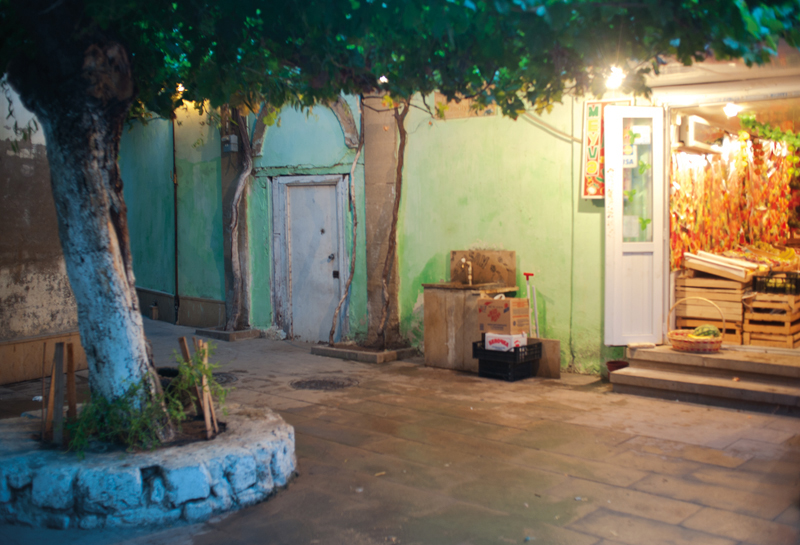
Baku, Azerbaijan—A quiet square in old Baku has a small produce shop that stays open late.
Clockwise from top: Cucumber and Tomato Salad with Pomegranate Molasses (see recipe), Onion Salad with Barberries, sumac, and mint leaves.
This simple dish of seasoned sliced onions, a cross between a salad and a condiment, pairs well with meat or vegetable stews, and with roast meats. It is an Azeri take on onion salad, flavored by and made attractive with a garnish of barberries. The tartness of the berries is a pleasing contrast to the sweetness of the onions. You can use pomegranate seeds instead for a similar effect.
Serves 4 as a salad/condiment
2 large onions, thinly sliced
Sea salt
About ¼ cup dried barberries (see Glossary), soaked for 20 minutes in lukewarm water and drained
1 teaspoon dried mint, 2 teaspoons Mint Oil (see recipe), or 2 tablespoons finely chopped fresh mint
½ teaspoon ground sumac
Place the onions in a bowl, sprinkle on 2 teaspoons salt, and mix with your hands to distribute the salt. Set aside for 15 minutes.
Pour cold water into the bowl of onions to cover, mix a little with your hand, and drain. Repeat, squeezing the onions gently but firmly to rid them of the salty water.
Place the drained onions in a shallow serving bowl. Add the barberries and toss. Add the dried mint or mint oil or fresh mint and toss. Sprinkle on another ¼ teaspoon salt and toss, then taste and adjust the seasoning if needed. Sprinkle with the sumac and serve.
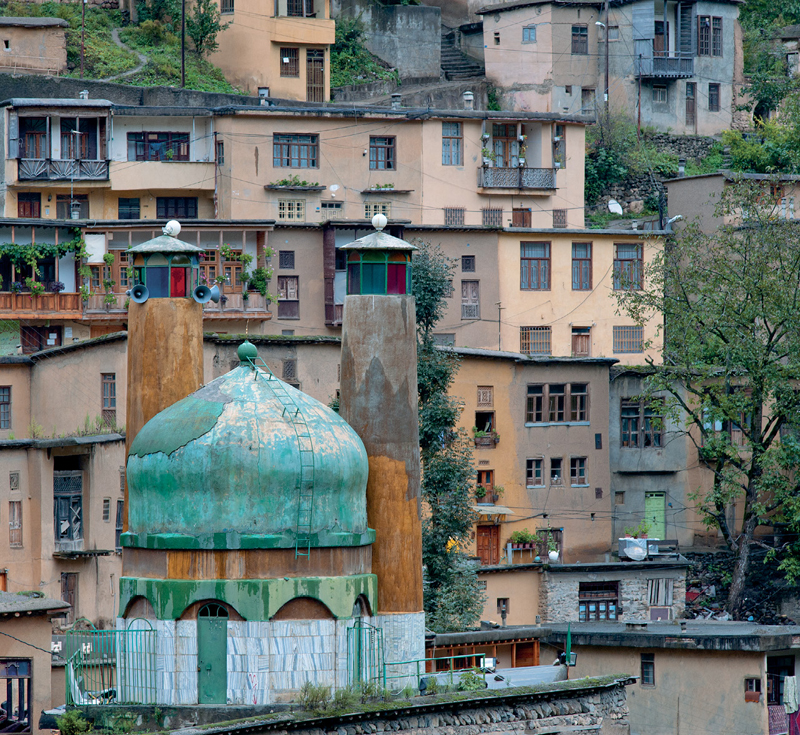
Massouleh, northern Iran—A tourist destination for Iranians, this hillside village has lush vegetation and a humid climate that’s very different from most of Iran.
“Your Iran visa has been approved” was the long-awaited e-mail message one August day. At last—I was thrilled. Not so my family and friends, who were worried about my going on my own to take photographs and do research for this book.
The reverse of all that worry by people at home was the reaction of people in Iran. I was made to feel very welcome by everyone I met, English-speaking or no. They were often curious: “What do you think of Iran?” “Were you afraid of Iranians before you came?” I would answer that I had never been afraid of Iranians, but that I had friends who were worried.
When I got there, in October 2013, the newly elected president, Rouhani, was already several months into his charm offensive with the United States and its allies. Iranians I met were pleased that he and President Obama had talked and that there might be a détente. They were tired of sanctions and of their country being treated as a pariah. They were also tired of being ruled by theocrats, the ayatollahs.
In the meantime, they had developed a lot of work-arounds to help them cope with the restrictions imposed on them by those religious leaders. Unlike in Burma, where totalitarian rule left people frightened, in Iran I felt that people refused to be afraid, and instead tried to figure out ways of living their lives as fully and freely as possible.
So they would laugh at my questions about religious observance: “Of course we have respect for mosques and shrines,” they’d tell me, “but only ten percent of the population is truly religious, and another ten percent finds it convenient and more practical to act religious.” Or they’d say, “In truth, we are not extremists. We are Persians and we have our own calendar, a solar calendar that is not the Islamic calendar. We celebrate the seasons.” And they’d tell me that most Iranians try to get by with minimal observance of the rules about avoiding alcohol and about clothing for women and girls.
What I saw confirmed this: People buy liquor and beer from trusted sources, and many women in the more liberal atmosphere of the bigger cities— Tehran, Shiraz, and Isfahan—were wearing head scarves perched way back on their heads, and extremely formfitting clothing. People know that there are occasional crackdowns, with the “scarf police,” as I thought of them, set up at busy intersections to chastise women for showing too much hair or neck. But most people are relaxed about the rules. Or at least so it seemed to me.
The result was that I felt very at ease in Iran. I walked around with my camera, knowing I was very obviously a foreigner, and felt no sense that people were eyeing me to take advantage. I walked on my own all over, and only at dusk in the rather deserted covered alleys of Yazd, ill-lit and buzzed by the occasional speeding motorcycle, did I ever feel slightly uneasy.
Early on, I traveled by prearranged car between some cities, almost always with a driver who spoke little or no English. Distances were huge, the highways multilane and fast, and there was little incentive to stop. So I began to choose public transit in preference to a car.
I took a long-distance bus south from Yazd to Kerman and an overnight train from Kerman to Mashad. I loved the public transportation, because it was a chance to be thrown into a crowd of strangers, always an interesting experience in another country. Women were very welcoming and generous to me. We shared sunflower seeds and raisins, smiles, and gestural conversations that felt relaxed and intimate.
I want to keep going back.
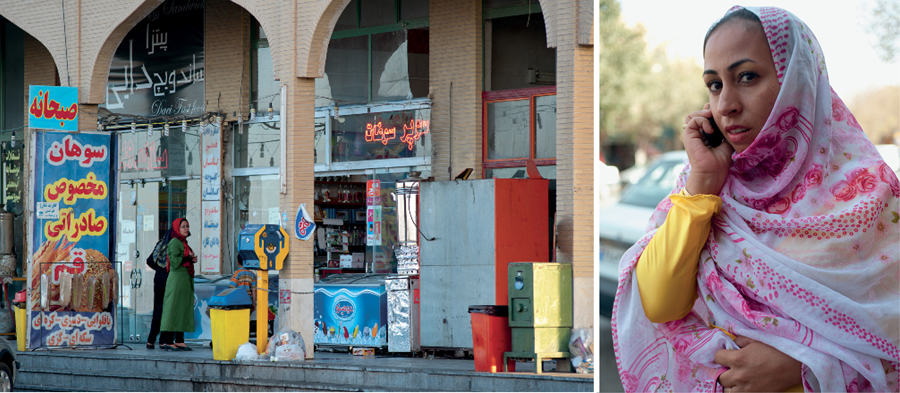
Left: Kashan, Iran—Two women outside a shop in this town famous for its scented waters distilled from flowers and plants.
Right: Yazd, Iran—A Zoroastrian woman (identifiable by her bright clothing and head covering). Yazd is home to a large population of Zoroastrians (see Zoroaster’s Legacy).
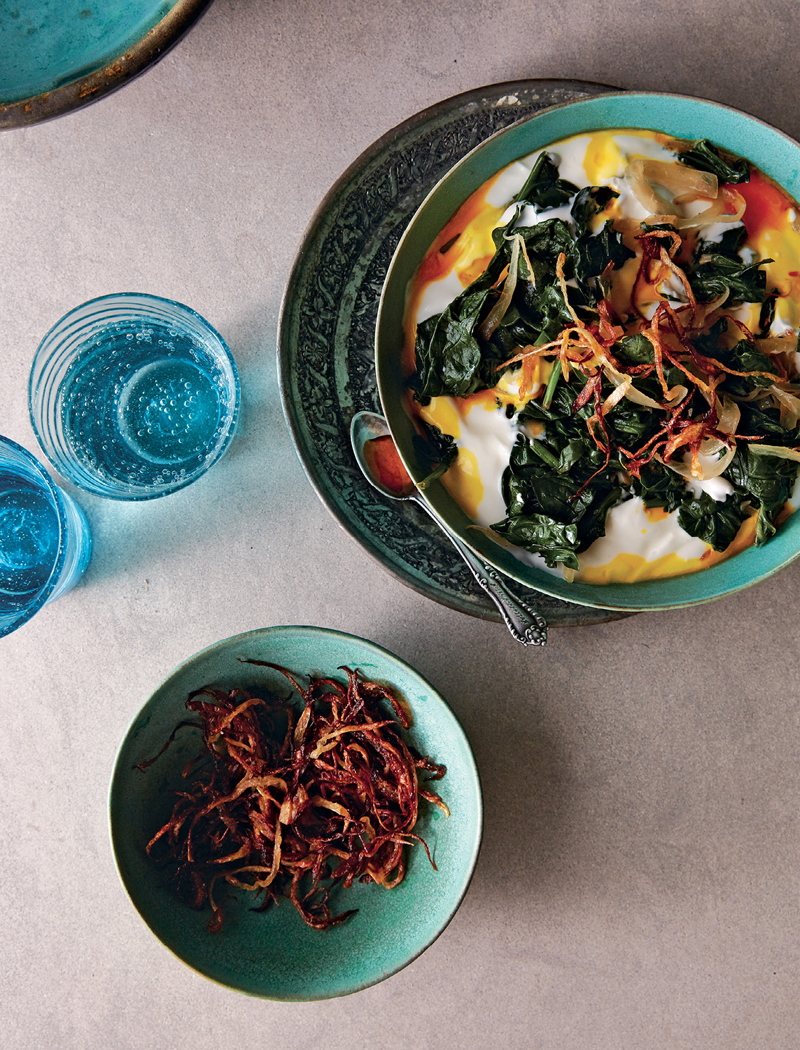
Spinach Borani, topped with saffron water and fried onions.
The Persian dishes called borani are a genius combination of cooked vegetable and thick drained yogurt. They are generally topped with fried onions, and often with a scattering of lightly toasted walnuts. People rave whenever I serve them, especially this spinach version.
Serves 4 to 6
About 1½ cups plain full-fat yogurt
2 pounds spinach
About 2 tablespoons sunflower or extra-virgin olive oil
1 medium onion, thinly sliced
1 teaspoon sea salt, or to taste
1 tablespoon water
About 1 tablespoon Saffron Water (see recipe)
2 to 3 tablespoons coarsely chopped lightly toasted walnuts
Drain the yogurt to thicken it: Line a sieve or colander with cheesecloth or a cotton cloth. Moisten the cloth with water. Set the sieve or colander over a bowl and add the yogurt. Set aside, loosely covered, to drain for about 30 minutes.
Meanwhile, trim the tough stems from the spinach. Wash the spinach thoroughly in several changes of water and drain well. Coarsely chop and set aside.
Heat the oil in a wide heavy skillet over medium-high heat. Add the onion, lower the heat to medium, and fry the onion until translucent and touched with color, about 5 minutes. Transfer the onion to a plate and set aside.
Raise the heat under the skillet to medium-high and add the spinach, turning it to expose it to the hot surface. Add about ½ cup water and cook, pressing and turning the spinach, until it is well wilted and deep green, 4 to 5 minutes. Transfer the spinach to a bowl to cool slightly.
Once the spinach is cool enough to handle, squeeze it thoroughly, a handful at a time, to press out excess water.
Transfer the spinach to a bowl, add ½ teaspoon salt, and mix well.
Turn the thickened yogurt out into a bowl; you’ll have about 1 cup. Add the remaining ½ teaspoon salt and the water to loosen the yogurt slightly and stir. (Save the whey for another purpose or discard.) Add the yogurt to the spinach and stir gently to mix them a little, but not into a smooth blend, leaving the mixture with patches of white and dark green. Taste and adjust the seasoning if necessary.
Strew on the fried onions, sprinkle with the saffron water and toasted walnuts if you wish, and serve.
You can make borani with other vegetables too. One of the most appealing is beet borani—the yogurt’s slight tartness is a great foil for the sweetness of the beets. Place 6 medium beets (1½ to 2 pounds) in a roasting pan, coat with a little oil, and roast at 400°F until cooked through, about 1 hour, or boil them whole until cooked through. Let cool. Peel the beets and chop into about ½-inch dice. I have a weakness for beets with cumin or fennel, so I suggest tossing a generous pinch of one or the other into the pan as you fry the onion, along with ½ teaspoon salt. Once the onion is softened and touched with color, add it to the chopped beets. To serve, combine the beets with about 1 cup drained yogurt (from 1½ cups full-fat yogurt) seasoned with ½ teaspoon salt, without mixing them completely. Top with about 3 tablespoons coarsely chopped toasted walnuts or, for a splashier look, with coarsely chopped pistachios.
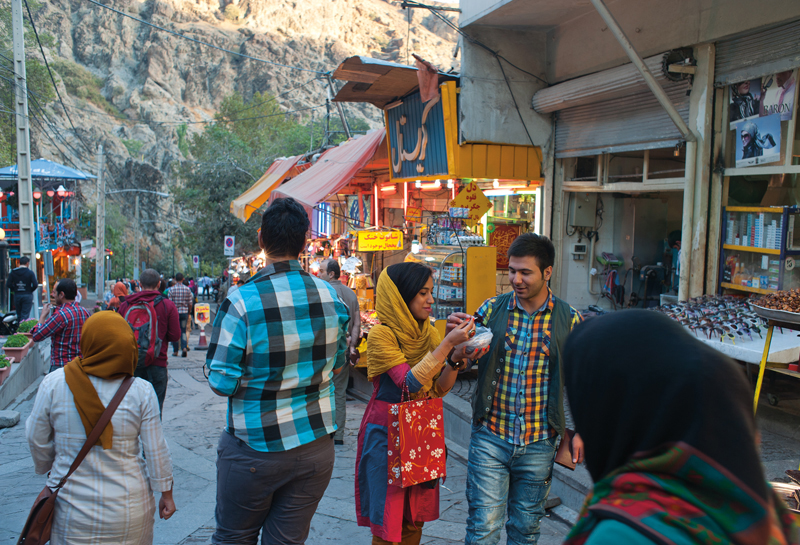
Darband, Tehran, Iran—On Saturdays, Darband is an especially popular place with young people. A path leads up past rocky cliffs to Mount Tochal, which towers over Tehran. The first part of the route is where most people hang out, because it is lined with little shops and cafes where friends go to smoke hookahs, sip tea or coffee, eat a little, and relax.
This yogurt, cheese, and herb dish from the Ararat Valley in the far south of Armenia is known as an omelet without eggs. In fact, it’s more like a thick vegetable-laden sauce, rich with yogurt and a little cheese, and delectable as a vegetarian main course or as an appetizer.
Shepherds in Armenia, as in many places, set out with their flocks in search of grazing, either for the day or for weeks at a time. They travel light, with some bread and cheese and other staples, and they have access to milk from the flock. But of course there are no chickens in the party, and no eggs available. Hence this improvised dish, which has become fancier over time with the addition of chopped red pepper, tomato, and black pepper. The optional turmeric tints it yellow and makes it look as if there are eggs in it. The original would have been made with only yogurt or fresh cheese, loads of wild herbs, and perhaps some crumbled bread. Hovivi has a thick, creamy texture, like a very thick soup. I like to serve it as a first course in small bowls, with flatbread or toast alongside.
Serves 2 as a main course, 6 as an appetizer
1½ cups full-fat sheep’s- or cow’s-milk yogurt or 1 cup plain thick yogurt (see Glossary)
1 tablespoon all-purpose flour or 2 tablespoons rice flour
½ teaspoon sea salt
2 tablespoons sunflower or vegetable oil
¼ teaspoon turmeric (optional)
1 cup thinly sliced onion
1 small red bell pepper, cored, seeded, and chopped into ½-inch pieces
1 tomato, peeled and chopped
¼ cup crumbled or chopped cheese—a mix of feta and either medium cheddar or aged sheep’s-milk cheese
Generous grinding of black pepper
Generous ½ cup chopped fresh sorrel, tarragon, mint, coriander, flat-leaf parsley, and/or dill
If using the 1½ cups yogurt, line a sieve or colander with cheesecloth or a cotton cloth. Moisten the cloth with water. Set the sieve or colander over a bowl and add the yogurt. Set aside, loosely covered, to drain for about 30 minutes.
Put the thick yogurt in a bowl and stir in the flour until smooth. Stir in the salt; set aside.
Place a heavy skillet over medium heat and add the oil. When it is hot, add the turmeric, if using, the onion, and red pepper. Stir, cover, and cook for about 5 minutes, until the onion is translucent and the pepper is softened. Add the tomato, stir, and cook for 4 to 5 minutes, until well softened. Stir again, sprinkle on the cheese, and pour in the yogurt mixture. Bring to a low boil and cook, stirring, for 30 seconds. Add the black pepper and herbs, then remove from the heat and let stand for a minute.
Taste and adjust the seasonings if needed. Serve hot in bowls.
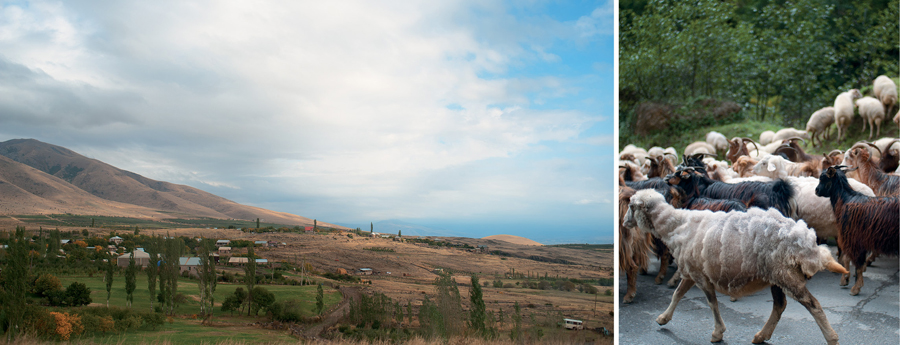
Left: North of Yerevan, Armenia—Most of Armenia is big-sky country whose climate is mild enough for fruit trees. But as the road climbs higher, agriculture is tougher: People grow potatoes and some grain, and perhaps apples, and the rest of the land is used for grazing sheep and goats.
Right: Near Massouleh, northern Iran—A small rain-soaked herd of sheep and goats on a narrow road between Massouleh and the Caspian coast.
In Iran, as in Thailand, Serbia, and other parts of the world, grilled eggplant is a much-loved everyday food. I had always thought that I needed to grill eggplant over charcoal to get a smoky taste, and that cooking it under a broiler was the only other option. But in Iran, home cooks grill their eggplants directly over a medium-high gas flame on the stove. It’s simple, and it gives the desired blackened grilled taste to the eggplants. It’s easier and more stable if you place a mesh rack on the gas burner and the eggplants on that.
If you don’t have a gas stovetop, either grill the eggplants on a charcoal or gas grill over medium heat until they are softened all over, or put them on a rimmed baking sheet and bake them in a 400°F oven until softened. Remember to prick them all over with a fork before cooking them.
I let the grilled eggplant sit for 10 to 15 minutes in a brown paper bag because it gives the flesh time to steam and cook right through. (This is especially necessary if you are using fatter round Mediterranean eggplants.) Then I scoop the flesh off the skin into a bowl and discard the skin. After that, I can mash it or chop it and use it in a multitude of ways. Yields vary, but in general, 1 round eggplant yields 2 cups cooked flesh.
You’ll notice that if you let the cooked eggplant sit for a while in a bowl, liquid accumulates in the bottom. The liquid is full of flavor; stir it back into the flesh before seasoning it.
Grilled Eggplant Options: The repertoire of the Persian culinary world is rich in possibilities for grilled eggplant. Try it topped with Walnut Sauce (see recipe) and a scattering of chopped herbs, or with thickened yogurt to make a borani (see recipe), or with kashk (see recipe). Or instead make it into a Georgian pkhali, a walnut-based vegetable pâté (see recipe).
This Iranian classic, which I learned from a friend in Shiraz, is a fresh-tasting treat with lovely smoky undertones. A Druse friend from Syria tells me that this dish is the “real” baba ghanouj. That’s the name it has in Syria and Lebanon.
Serves 4 or 5 as a side dish
2 cups mashed peeled grilled eggplant (from 1 pound eggplants; see Grilled Eggplant)
Generous 1 tablespoon dried mint, or to taste
1¼ teaspoons sea salt, or to taste
½ cup finely chopped shallots or sweet onion
2 cups pomegranate seeds (from 1 large fruit; see Pomegranate Techniques)
Place the eggplant in a bowl, add the dried mint, salt, and shallots or onion, and stir to mix well. Add the pomegranate seeds and fold them in. Let stand for 30 minutes, if you have the time; this gives the flavors a chance to blend.
Just before serving, taste and add a little more dried mint and/or salt if you wish and stir it in thoroughly.

Yazd, Iran—A motorcycle “packhorse” is parked at the bazaar waiting to be loaded up. Reading license plates is a great way to practice Arabic numbers.
Another in the Persian borani family (see Spinach Borani), this combo of smoky eggplant with creamy yogurt and fried onions is a great addition to any meal. I prefer thinner Asian eggplants, which cook more quickly and evenly than the round Mediterranean ones. Use whichever type you prefer.
Serves 4 to 6
2 cups plain full-fat yogurt
1 pound eggplant (3 medium Asian eggplants or 1 to 2 large Mediterranean eggplants)
Sunflower or extra-virgin olive oil
2 medium onions, thinly sliced
2 garlic cloves, minced
1 teaspoon sea salt, or to taste
1 tablespoon water
About 2 tablespoons chopped fresh mint or tarragon (optional)
Drain the yogurt to thicken it: Line a sieve or colander with cheesecloth or a cotton cloth. Moisten the cloth with water. Set the sieve or colander over a bowl and add the yogurt. Set aside, loosely covered, to drain for about 30 minutes.
Meanwhile, prick the eggplants all over with a fork, ten or twelve times. You can cook them on a gas stovetop, on a gas or charcoal grill, or in the oven.
To use the stovetop, place each eggplant directly on a gas burner turned to medium-high and cook, turning frequently, until very softened and charred, 10 minutes or more, depending on the size of the eggplant. Alternatively, cook them over a medium fire in a gas or charcoal grill, until very soft, turning them frequently. Or preheat the oven to 400°F, place the eggplants on a rimmed baking sheet, and bake in the center of the oven until very softened and sagging, about 15 minutes.
Place the eggplants in a brown paper bag to steam-cook and cool for 10 to 15 minutes. Halve the eggplants, scrape the flesh out of the skin, and discard the skin. Mash or chop the flesh and transfer to a bowl. Set aside.
Heat a scant 2 tablespoons oil in a medium skillet over medium-high heat. Add the onions and cook until translucent and slightly touched with color, about 5 minutes. Remove and set aside. Place the skillet over medium heat and add a little more oil. Add the garlic and cook briefly, until softened.
Stir the garlic into the eggplant, along with ½ teaspoon of the salt. Taste and adjust the seasoning if necessary.
Turn the thickened yogurt out into a bowl; you’ll have about 1 cup. Add the remaining ½ teaspoon salt and the water to loosen the yogurt slightly and stir. (Save the whey for another purpose or discard.)
Place the eggplant in a wide shallow serving bowl, add the yogurt, and stir to combine them without blending them completely. Top with the fried onions and a sprinkling of tarragon or mint if you wish. Serve warm or at room temperature.
A favorite flavoring for grilled eggplant in Iran is kashk, a dried-milk product that tastes and smells like pungent cheese. It’s available in Persian, Arab, and Turkish grocery stores (for more about kashk, see Glossary). Like other fermented foods, kashk can be an acquired taste, but I find it delectable. To make kashk-e-bademjan, omit the yogurt and garlic and follow the instructions above to the point where you have the eggplant puree in a bowl and the onions sautéed. Dilute ½ cup kashk paste (for instructions for reconstituting dried kashk, see Glossary) with 1 tablespoon warm water. Stir 1 teaspoon dried mint and 1 teaspoon salt into the eggplant and transfer it to a shallow bowl. Dollop the kashk onto the eggplant and stir it in. Sprinkle on the fried onions. Let stand for 5 to 10 minutes to give the flavors time to blend. Invite your guests to scoop up the puree with pieces of flatbread.
I like this Kurdish eggplant and tomato stew for its clean taste and its flexibility: It can be served as a vegetable side—to accompany roast lamb or roast chicken, for example—or as the main dish in a simple meal with Kurdish Black Rice (see recipe), a plate of fresh herbs and greens, and cheese. If you wish, you can add a little ground lamb or beef (say ½ pound) when you start to fry the eggplant. Unlike Iranian vegetable dishes, which usually start with a base of cooked onion, Kurdish shleys use no onion.
The eggplant, which is peeled in strips and cut into short spears, fries in a little turmeric-and-cumin-flavored oil before it is simmered in a tomato sauce. Serve with a generous heap of fresh greens such as watercress or arugula, and put out some feta or another salty, crumbly cheese. Invite your guests to stir the greens into their stew. They can sprinkle small pieces of cheese onto their bowls of shley, or eat the cheese with bread as part of the meal.
Serves 4 as a side dish, 2 as a main course
1 pound eggplant (3 medium Asian eggplants or 1 large Mediterranean eggplant)
¼ cup sunflower or extra-virgin olive oil
¼ teaspoon turmeric
1 teaspoon ground cumin
2 cups water
1 cup unsalted canned crushed tomatoes or tomato puree
½ teaspoon salt (see Note)
2 cups chopped watercress, tender arugula, or fresh flat-leaf parsley
About ¼ pound feta or other salty cheese
Trim the eggplant and peel it in strips, leaving about half the skin on. Cut into 1½- to 2-inch lengths, then cut each length into spears about the size of your little finger. Set aside.
Place a wide heavy pot over medium heat. When it is hot, add the oil, and then the turmeric and cumin, and stir for a moment. Toss in the eggplant and turn and stir it to expose all surfaces to the flavored oil. Add 1 cup of the water and the tomatoes or tomato puree, stir, and bring to a vigorous boil. Add the second cup of water and the salt and boil vigorously, uncovered, for 15 minutes, stirring occasionally to make sure that the sauce doesn’t burn or stick; lower the heat if necessary.
Cover, turn the heat to very low, and simmer for about 20 minutes, until the flavors have blended.
Serve hot or at room temperature. Put out the greens and cheese, or top each serving with some of each and invite guests to stir them into their stew.
Note on Seasoning: I have kept the salt minimal, because I like to sprinkle salty feta on my shley. If you are serving it with cheese on the side, rather than sprinkled on top, increase the salt to ¾ to 1 teaspoon to taste.
You can make this recipe with other vegetables. Substitute 1 pound small young okra, sliced green beans, chopped zucchini, or chopped cauliflower florets for the eggplant. Cooking times will differ (the zucchini will cook in a very short time, and the green beans too if they are young and tender).
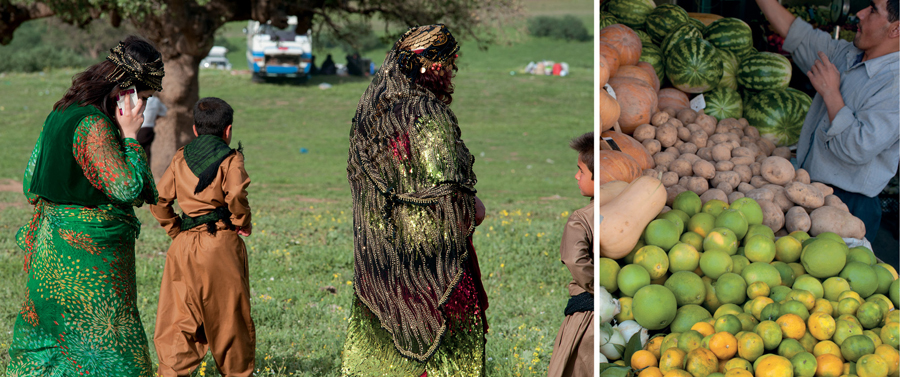
Left: Near Sulaymaniyah, Kurdistan—Kurdish women dressed in their finest, at a big festival held out in the country.
Right: Yazd, Iran—One of many fruit and vegetable shops in this desert city. Most of the bazaar is roofed to protect against the hot sun of summer and the icy winds of winter.

Southern Kurdistan, near Halabja—The beautiful and bare rolling green hills, less than ten miles from the border with Iran, were an escape route for families who fled Saddam Hussein during his war on the Kurds.
Hoshida, who lives in the town of Halabja, in the hills of southern Kurdistan, swept me up into her daily routine as if I were one of her grown children come for a visit. She taught me words in Kurdish as I did kitchen chores alongside her, and she showed me how to make Kurdish rice and other dishes. I don’t know what she thought of me, this visitor from Canada—a friend of her journalist son—busily asking endless questions, taking notes and photographs. Like the rest of her family, she was very tolerant, and I think she found me entertaining. I, in turn, was struck by her calm dignity, her grace, her generous welcome.
In the days that I stayed with her I explored the town; went driving out into the green hills with three of her sons; learned to make nane-tire (Kerchief Flatbreads) from her oldest daughter, Dila; and sat around for hours with various members of her large family—and frequent visitors—on the thickly carpeted floor listening to them speaking Kurdish and picking up a word here and there, while sipping glass after glass of sweet black tea. With no Internet, the pace of life was different, more deliberate and unhurried, with lots of conversation.
Apart from prostrating herself to pray, Hoshida is constantly getting up and down, for everything in the household takes place on the carpeted floor: eating, sleeping, praying, and sitting around. A sheet of plastic is laid out on the carpet for a dining table and onto it go bowls and plates and stacks of flatbread, as well as the cooked dishes; and at night, sleeping pads and blankets come out of an alcove and are unfolded and laid on the floor. The men sleep in one room and the women and children in another.
When I left Halabja to travel to the city of Sulaymaniyah, there was no chance I could stay in a hotel there; I had to stay with Hoshida’s son Yusef and his wife. Everything depends on family and family connection in Kurdistan. Once you belong, the family is committed to you and you have an obligation to them as well, to work within their codes of behavior.
And so when I was in Sulaymaniyah I ran into a problem. I was invited to lunch by a Kurdish couple that Yusef and I had met one day at a bakery. But Yusef told me I couldn’t possibly go to their place at noontime, for he’d be at work then. I could only go for the evening meal, when he’d be able to come with me. To explain why, he said, “We don’t know them,” which meant “they aren’t family,” and so as the man of the household, he had to accompany me. His protectiveness was a totally new and touching experience for me. But it was also a little confining, a taste of how tradition and modernity must collide every day in Kurdistan.
Another evening in Sulaymaniyah I was taken out to dinner by a close friend and confidant of the family, a successful lawyer named Hillal who is also from Halabja. We ate Italian food (breaking my rule about not eating anything but local dishes when I travel) at a newly opened restaurant. We drank imported red wine, a special pleasure for me after many days with no wine. But Hillal was a little concerned. He told me that Yusef would disapprove of his drinking (and of mine) and that I mustn’t tell him.
As it turned out, Yusef never asked me where we’d gone for supper; perhaps he thought it was better not to know.
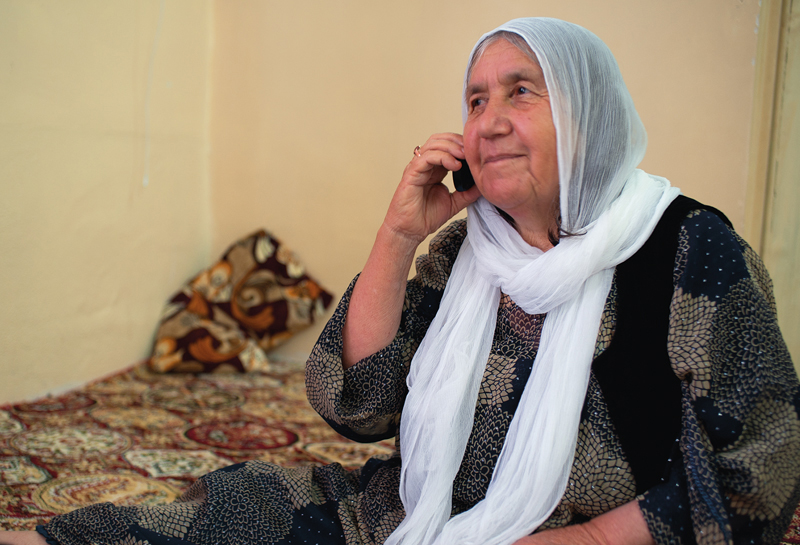
Halabja, Kurdistan—Hoshida, the generous and loving mother and grandmother whom I stayed with, sits in her house talking on the phone to someone in her large family.
Georgian vegetable pâtés—pkhali—are delicious. Cooked finely chopped or pureed vegetables are combined with loads of ground walnuts and with spices, minced garlic, and fresh herbs. Among my favorites are the leek pâté and this eggplant version. The smoky flavor of the roasted eggplants pairs beautifully with the richness of the walnuts and with the spice blend.
Serve this as a side dish or put out with bread, crackers, or toast as an appetizer.
Serves 6
About 1 pound eggplant (3 medium Asian eggplants or 1 large Mediterranean eggplant)
1 cup walnuts or walnut pieces
1 medium garlic clove, minced
1 teaspoon sea salt, or to taste
1½ teaspoons ground blue fenugreek, or 1½ teaspoons powdered dried fenugreek leaves plus ½ teaspoon ground fenugreek (see Note)
1 teaspoon ground coriander (see Note)
½ teaspoon powdered dried red chiles, or to taste (see Note)
¼ cup finely chopped fresh coriander or a mix of coriander and tarragon, plus (optional) a few sprigs for garnish
Prick the eggplants all over with a fork. Grill them over a gas or charcoal flame until they are well charred and softened. Transfer to a brown paper bag, close it tightly, and set aside to steam for 20 minutes.
Halve the eggplants and scrape the flesh out of the skins. Set aside.
Place the walnuts and garlic in a food processor or large mortar and process or pound to a coarse paste. Add the salt, fenugreek, coriander, and chiles and pulse or mix to blend. Add the eggplant and process or pound to a coarse puree. Taste and adjust for seasoning and chile heat. Turn out into a medium bowl and stir in the fresh herbs.
Cover and refrigerate for at least several hours, or overnight, to firm up. (You can serve the pkhali immediately, but it will be sauce-like rather than firm.)
Serve the pkhali from the bowl or turn out onto a plate and top with herb sprigs if you wish.
Note: If you have Georgian spice blend, either homemade (see recipe) or store-bought (see Glossary), use 1 tablespoon of the blend instead of the fenugreek, coriander, and chiles.
Leeks are featured in a starring role in this pkhali. They are simmered until soft and then combined with ground walnuts and spices. Make this several hours, or up to a day, ahead to give the flavors a chance to blend and the pâté time to firm up. Leftovers are delicious as a spread on bread or scooped up with lettuce leaves.
Serves 6 as an appetizer or a side dish
6 medium leeks, white and tender green parts only, chopped and well washed (about 4 cups)
1½ cups walnuts or walnut pieces
1½ teaspoons minced garlic
1½ teaspoons ground blue fenugreek, or 1½ teaspoons powdered dried fenugreek leaves plus ½ teaspoon ground fenugreek (see Note)
1 teaspoon ground coriander (see Note)
½ teaspoon powdered dried red chiles, or to taste (see Note)
¾ teaspoon sea salt, or to taste
1 tablespoon white wine vinegar or cider vinegar, or to taste
¼ cup finely chopped fresh coriander or a mix of coriander and tarragon
Crackers or bread for serving
Place the leeks in a wide pot, add about 1½ cups water, and bring to a boil. Cover and cook for 10 minutes, then uncover, lower the heat, and simmer until the leeks are very tender, another 10 to 15 minutes. Drain and set aside.
Grind the walnuts and garlic to a coarse paste in a food processor or a large mortar. Add the spices and salt and pulse or stir, then add the leeks and vinegar and process or pound to a coarse paste.
Transfer to a small deep bowl and stir in the chopped herbs. Taste and adjust the seasoning if you wish. Smooth the top, cover, and refrigerate for at least 2 hours, or as long as a day.
To serve, turn the pâté out onto a plate and serve with crackers or bread.
Note: If you have Georgian spice blend, either homemade (see recipe) or store-bought (see Glossary), use 1 tablespoon of the blend instead of the fenugreek, coriander, and chiles.
Start with a generous pound of whole beets and roast or boil them (see here). Peel them, chop them coarsely, and grind in a food processor. Combine with a generous 1 cup ground walnuts. Double the amount of garlic and vinegar to balance out the beets’ sweetness and stronger flavor. Add the spices as opposite and increase the salt to 1 teaspoon, or to taste.
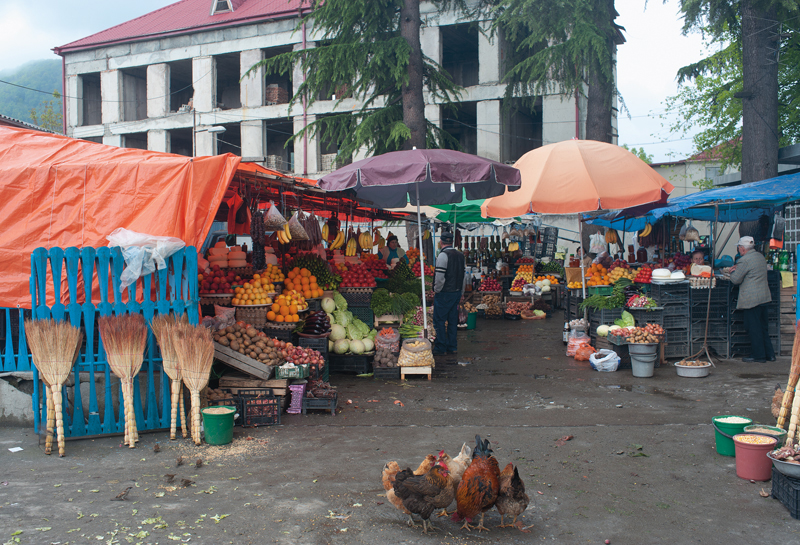
Eastern Georgia—A small country market not far from the Azerbaijan border. In early spring, local potatoes, cabbage, onions, beets, dried beans, dried fruit and churchkhela (see here), dried corn, and other winter staples are on offer, along with citrus, eggplants, and bananas imported from Turkey.
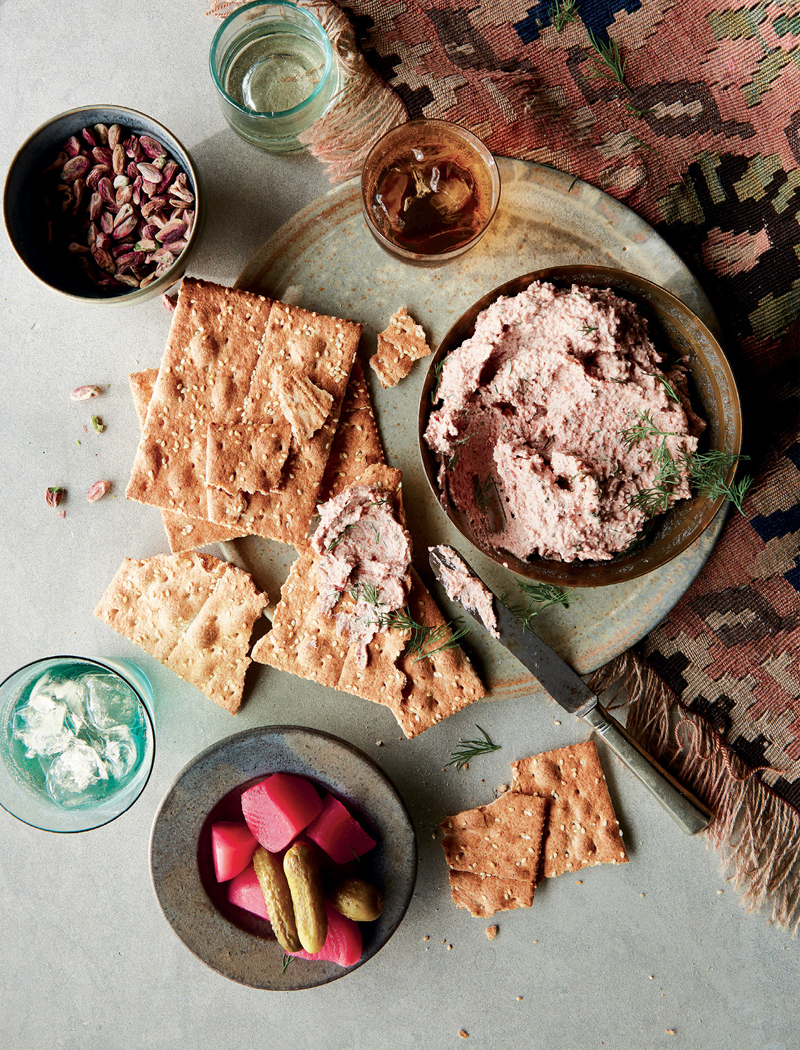
This lobahashu, a dish from the Lori region of Armenia, which borders on southeastern Georgia, blends finely ground walnuts into cooked mashed kidney beans. The result is a creamy, garlicky pâté tinted pale pink by the beans. If you can, make it a day or even two days before you wish to serve it (and keep it in the refrigerator). The flavors deepen and blend remarkably over time.
I like spreading this on bread or scooping it up with crackers. Guests love it and can’t get enough of it. Serve as an appetizer or a snack. I also like to put this out as part of a meal, another hit of flavor available on the table.
makes about 4 cups
2 cups walnuts or walnut pieces
3 garlic cloves, minced
4 cups cooked kidney beans (see Note)
2 tablespoons sunflower or olive oil
1½ teaspoons sea salt
Generous grinding of black pepper
About ½ cup chopped fresh dill, tarragon, or coriander, or 1½ teaspoons dried mint
Place the walnuts in a wide heavy skillet over medium heat and toast them, stirring them frequently so they don’t scorch, until aromatic, about 5 minutes. (The recipe I learned in Armenia did not include this toasting, but it assumed locally grown superb walnuts; the toasting helps bring out the flavor of the nuts.) Let cool for 10 minutes, then transfer them to a food processor and process to a fine texture. Add the garlic and beans and process to a smooth puree. Stop occasionally and scrape down the sides of the bowl to ensure that all the beans are incorporated.
Turn the mixture out into a bowl, add the oil, salt, and pepper, and stir thoroughly. Stir in the herbs.
Serve at room temperature. Refrigerate any leftover pâté in a well-sealed container for up to 5 days (though it is unlikely to last that long).
Note: See The Precooked Beans Habit. And if you want to use canned beans instead of homemade, drain and rinse the beans, place in a pot with about ½ cup water, and bring to a boil. Simmer for 10 minutes or so. Check to see that the beans are tender. Let cool to room temperature, in their liquid, before using.
In central Tabriz, the largest city in the Azeri region of Iran, I found a street vendor selling boiled potato and hard-boiled egg mashed together, seasoned, and rolled up in a supple flatbread. It’s a satisfying combo, one that workingmen stop by for when they have a break.
I stepped up and nodded to the guy. He reached for a flap of flatbread, lifted out a hot potato, slid off its peel, and placed it on the bread, then folded the bread over and pressed down to mash the potato. He opened the bread again, lifted out a hard-boiled egg from a pot, and peeled it with a practiced flip of the wrist, then put the egg onto the potato and flattened it with the side of a knife. Finally, on went some chopped scallions, as well as salt. He folded my bread package and handed it to me with a nod as I handed him his money.
You can extend this idea to include other herbs (tarragon leaves are a good choice, or basil or mint) and sauces: A dab of Green Ajika (see recipe) or Walnut Sauce (see recipe) gives another layer of flavor.
This is great picnic food for a crowd. Precook your potatoes and eggs. Take along a good stack of supple flatbreads, some fresh herbs and greens, salt and pepper, and a condiment sauce or two. Invite people to make their own wraps, or set up a production line and feed your guests with speed and ease.
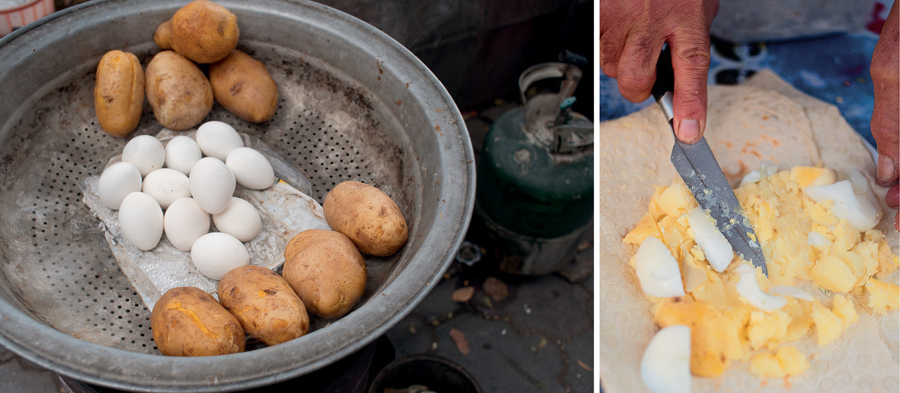
Tabriz, Iran—Hard-boiled eggs and boiled potatoes, ready for use (left). A vendor uses a knife to mash egg and potato onto a large flatbread before seasoning it and rolling it into a street-food wrap (right).
In the three Caucasus countries, home cooks have an easy fallback dish that pleases everyone: sliced fried potatoes. Whether it came in with Russian influence or whether it’s just a natural solution to what to do with potatoes when there’s no oven, it is indeed a pleasure. Once the potatoes are peeled and sliced, they take only fifteen to twenty minutes to cook.
The recipe is easily doubled.
Serves 4
1½ to 2 pounds waxy potatoes (6 medium)
About ½ cup sunflower or extra-virgin olive oil
1½ teaspoons sea salt or 1 tablespoon Svanetian Salt (see recipe), or to taste
Freshly ground black pepper (optional)
About 2 teaspoons ground sumac (optional)
Peel the potatoes and slice them into ¼-inch-thick slices.
Place a paper towel–lined platter or wide bowl by your stovetop.
Place a large cast-iron or other heavy skillet over medium-high heat and add about ¼ inch of oil. When the oil is hot, carefully slide in the potato slices. It’s fine if you have several layers of potatoes in the pan, but more than that and you will find it difficult to get them evenly cooked. If necessary, use two pans. Cook the potatoes until browned and tender. You want them to brown gradually; as they do, use a spatula to turn them and move them around so they cook evenly. (Lower the heat to medium if the slices start to scorch.) Use tongs or your spatula to lift out the slices once they are lightly browned on both sides and tender, and place them on the paper towels.
Once all the potatoes are cooked, blot with another paper towel. Serve hot, sprinkled with the salt and pepper or sumac, or a combination.
In the mountains of Azerbaijan, about a three-hour drive from Baku, I watched a home cook boil fresh-gathered mushrooms in water, a technique completely new to me. And when we sat down to eat, I was astonished—I’d never tasted mushrooms with such intense flavor. The next day, she made another version, starting the same way but adding whisked egg at the end to make a kind of mushroom scramble. They’re both recipes to treasure.
When I got back home, I was keen to experiment. Would ordinarily available mushrooms cooked this way be as delicious as those I’d eaten in Azerbaijan? The answer is a firm yes. Serve either as a vegetable side with meat, or as a vegetarian main dish.
Serves 4 as a side dish, 2 as a main course
½ pound white mushrooms, portobellos, or cremini, cut into bite-size pieces (about 3 cups)
About 1 tablespoon sunflower or extra-virgin olive oil
½ cup water
½ teaspoon sea salt, or to taste
2 tablespoons butter
Generous grinding of black pepper
About 2 tablespoons finely chopped fresh dill or scallions
Place the mushrooms in a wide heavy skillet or shallow pot over medium heat, add the oil, and shake the pan or stir the mushrooms to spread the oil around. Cook for about a minute, then add the water, raise the heat, and bring the water to a boil. Cover tightly and cook at a strong boil for about 5 minutes. Remove the lid, add the salt, and continue cooking at a medium boil to reduce the liquid. When the bottom of the pan is starting to show, add the butter and stir briefly, then cover and cook over very low heat for 5 to 10 minutes, until the mushrooms are very tender.
Taste for seasoning and adjust if needed. Add the pepper and serve hot or warm, topped with the chopped herbs.
This is a great breakfast or, served with soup and bread, light supper dish. Proceed as above until you have added the butter and reduced the heat. Let the mushrooms cook for a minute while you whisk 2 large eggs with ¼ teaspoon salt and the pepper. Raise the heat to medium, pull the mushrooms together into a pile, pour the eggs onto the mushrooms, and turn and stir to coat the mushrooms with egg and expose the egg to the hot pan. As soon as the egg has lightly set, turn the mushrooms out and serve sprinkled with the herbs and with ground sumac if you wish.
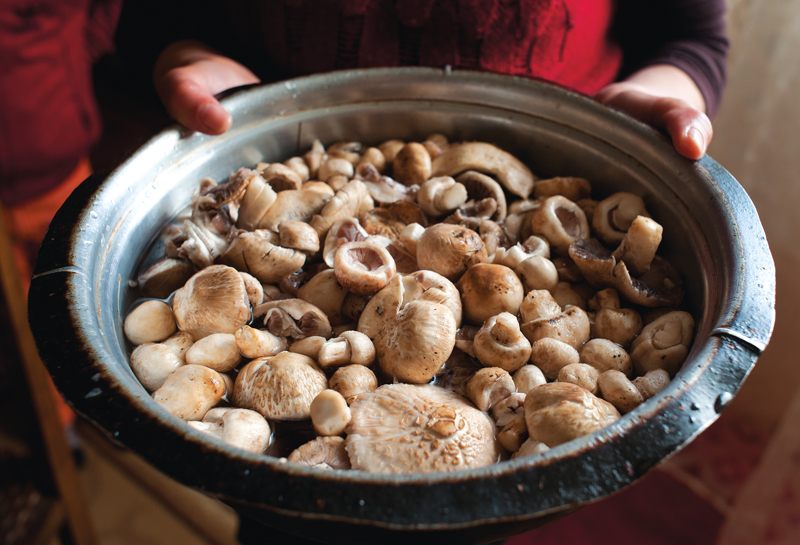
North of Yerevan, Armenia—A treasure of wild-gathered mushrooms in the village of Melikgyugh, near snow-topped Mount Aragats.
One of the most delicious foods I tasted while I was in Kurdistan was a simple-seeming combination: young cardoons (kundeer in Kurdish) enriched with a few eggs. I’ve looked long and hard for cardoons in North America. They are sometimes available, but I’ve never found the young tender ones that the Kurdish home cooks have in springtime. This recipe is the closest I can come to reproducing the enticing flavor and textures of the original.
Jerusalem artichokes, also known as sunchokes, have a flavor reminiscent of artichoke—and cardoons are a kind of wild artichoke relative. I love the way their sweetness and fragrance blend into the eggs. You can dress this up by adding fresh tarragon leaves to the whisked eggs, or by topping the finished dish with tarragon.
In Kurdistan, we ate the cardoon version with lavash and heaps of Kurdish Black Rice (see recipe) or Red Rice (see recipe).
Serves 4 for breakfast with flatbreads or toast, 6 as a side dish
1 pound Jerusalem artichokes (sunchokes)
2 tablespoons sunflower or extra-virgin olive oil
½ teaspoon ground cumin
Pinch of turmeric
Pinch of cayenne (optional)
2 tablespoons minced scallions, shallots, or onion
1 teaspoon sea salt
About 1 cup water
3 large eggs
Generous grinding of black pepper
1 tablespoon fresh tarragon leaves, coarsely chopped (optional)
Herb Plate (see recipe)
Flatbreads
1 lime or lemon, cut into wedges
Scrub the Jerusalem artichokes and trim off any tough or discolored areas. Thinly slice, then cut into ½-inch-wide strips. Set aside.
Place a wide cast-iron or other heavy skillet over medium-high heat. When it is hot, add the oil, cumin, turmeric, and cayenne, if using, then toss in the scallions, shallots, or onion and cook for several minutes, until softened. Add the chopped Jerusalem artichokes and ½ teaspoon of the salt and cook, stirring, for several minutes, until the artichokes are well coated with oil. Add about 1 cup water, or enough to give you a depth of ½ to ¾ inch in the pan, bring to a boil, cover, and cook for 5 minutes.
Meanwhile, whisk the eggs with the remaining ½ teaspoon salt, the pepper, and the tarragon, if using. Set aside.
At this point, the Jerusalem artichokes should be very tender; if they aren’t, cover again (add a little water if the pan is dry) and give them another couple of minutes. Once they’re done, if there’s any remaining water in the pan, cook uncovered for a moment to let it boil off.
Lower the heat, pull the artichokes together into a mound, and pour the eggs over. Turn and stir to coat the artichokes with egg and move them around on the hot surface until the eggs are lightly set, about a minute.
Turn out onto a serving plate or individual plates and serve with any of the optional accompaniments you please. The lime or lemon wedges are not traditional, but I find a squeeze of juice is a great complement to the sweetness of the dish.
If I have the time, I roast the artichokes in a 400°F oven rather than fry them. It makes them even sweeter. Thoroughly scrub them, but do not peel. Toss with a little sunflower or olive oil and spread out on a rimmed baking sheet. It will take 20 to 30 minutes to get them tender. Once they’ve cooled, chop them, peel and all, into bite-size pieces. You’ll need only 1 teaspoon oil for cooking the spices and scallions, then add the artichokes and heat for a moment before mounding them and coating them with egg, as above.
When you assemble all the greens and herbs called for in this recipe, it’s hard to believe that the eggs will hold them. Kuku is best served at room temperature. It can be an appetizer, or an accompaniment to soup for a simple meal, or one of many dishes in a larger spread. It also makes excellent picnic fare.
Many of the quantities for the ingredients below are given as a range, because the format is flexible. For example, if you have plenty of beautiful fresh spinach, use the larger amount for that and less lettuce; or if you have good leeks, then use more leek and less scallion. Make sure the greens are thoroughly washed and that all tough stems are discarded. The walnuts can go into the eggs, but I prefer them scattered on top, so they toast and keep a crisp edge.
You will need a heavy ovenproof skillet that is 10 inches in diameter; I use a cast-iron skillet and then transfer the cut wedges of kuku to a platter to serve.
Serves 6 as a light main course, 8 to 10 as an appetizer
1 to 1½ cups finely chopped leeks
1 to 1½ packed cups finely chopped spinach
½ to 1 packed cup finely chopped lettuce
½ to 1 cup finely chopped scallions
½ cup chopped fresh flat-leaf parsley
½ cup chopped fresh coriander leaves and fine stems
¼ cup finely chopped fresh dill
Scant 1 tablespoon all-purpose flour or 2 tablespoons rice flour
2 tablespoons water
8 large or extra-large eggs or 10 medium eggs, preferably farm-fresh
About 2 tablespoons plain full-fat yogurt
1 teaspoon sea salt
Generous grinding of black pepper
About 1 tablespoon sunflower or extra-virgin olive oil
½ to ¾ cup coarsely chopped walnuts
Place a rack in the upper third of the oven and preheat the oven to 325°F.
Place all the chopped greens and herbs in a large bowl and mix together; set aside.
Stir together the flour and water in a small bowl to make a paste; set aside.
Break the eggs into another bowl and whisk. Add the yogurt, the flour and water paste, and the salt and pepper and stir.
Heat a 10-inch cast-iron or other heavy ovenproof skillet over medium heat. Add the oil and tilt to coat the bottom of the pan. Remove from the heat.
Pour the egg mixture over the greens and stir, then pour the mixture into the hot pan. Sprinkle on the walnuts and bake for 45 minutes, or until the frittata is cooked through and set. Let stand for an hour or more to cool to room temperature before cutting into wedges and serving.
In rural Azerbaijan and Armenia, very little goes to waste, and people eat with the seasons. Springtime brings fresh greens—among them, tender nettles. Several people in Azerbaijan told me how wonderful a springtime kuku is made with young nettles, which are available in late March. The word for nettle in Azeri is gigityhan; people also refer to them by their Russian name, krapeeva. Substitute tender young nettle leaves for the spinach in the recipe above. Another early spring green you can use in place of the spinach is dandelion leaves.
But in winter, of course, there are no fresh greens. In all three Caucasus countries, during the summer and fall people gather a form of sorrel or dock, a tall plant, which is called avalleikch in Azeri. It’s wound into coils or braids and dried so that it can be stored for a long time. Then in winter, the dried greens come into their own: They are soaked and rehydrated, finely chopped, and added to soups, stews, or kuku.
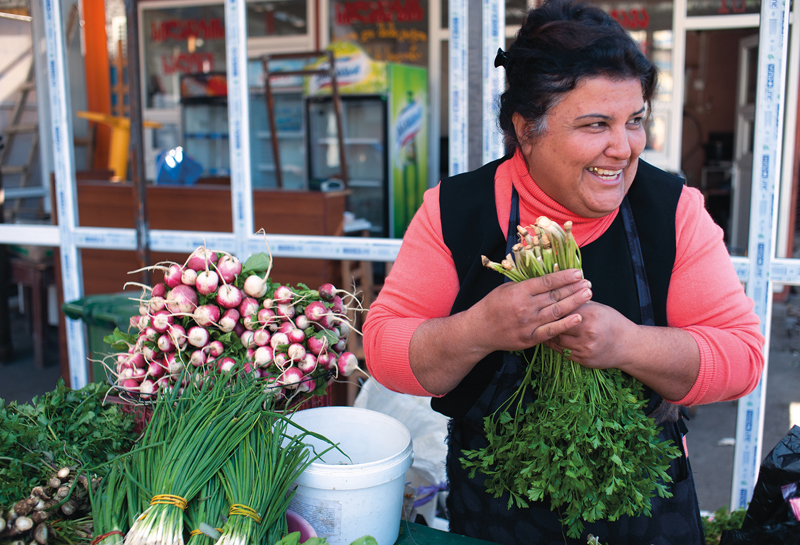
Tbilisi, Georgia—An herb and vegetable vendor holds a large bunch of flat-leaf parsley. Note the huge bunches of leaf celery, left, and the healthy vigor of the scallions and radishes.
Some beans take a long time to cook, and that can take them out of play if you’re in a rush. But if you have cooked them ahead they can help you get food on the table very quickly. I like to cook a large pot of beans, unseasoned, and freeze them, with their cooking liquid, in 2-cup batches. I love having a stash of beans in the freezer that I can quickly transform into soups or stews.
Wash about 3 cups dried beans, place them in a tall heavy pot with water to cover by 2 to 3 inches, and bring to a vigorous boil. (A pressure cooker is quicker, if you’d prefer to use that.) Partially cover, lower the heat to maintain a steady boil, and cook until the beans are tender. Navy beans take a generous hour; kidney beans and chickpeas can take 2 hours or more, depending on how dried out they are. Black-eyed peas take about an hour, and split peas and whole mung beans the same. Check the beans every once in a while to make sure the pot isn’t running dry, and add more hot water as needed. Once the beans are fully cooked, you’ll have about 8 cups soupy beans (about 6 cups beans and 1½ to 2 cups liquid). Leave them unseasoned until you want to use them.
Let the beans cool to room temperature before transferring them, with their cooking liquid, to well-sealed containers. Label and freeze.
Some of the recipes in this book call for plain cooked beans of some kind; you can, of course, start from scratch or substitute rinsed canned beans, but I urge you to get into the precooked beans habit. You’ll be pleased with the ease of it all.
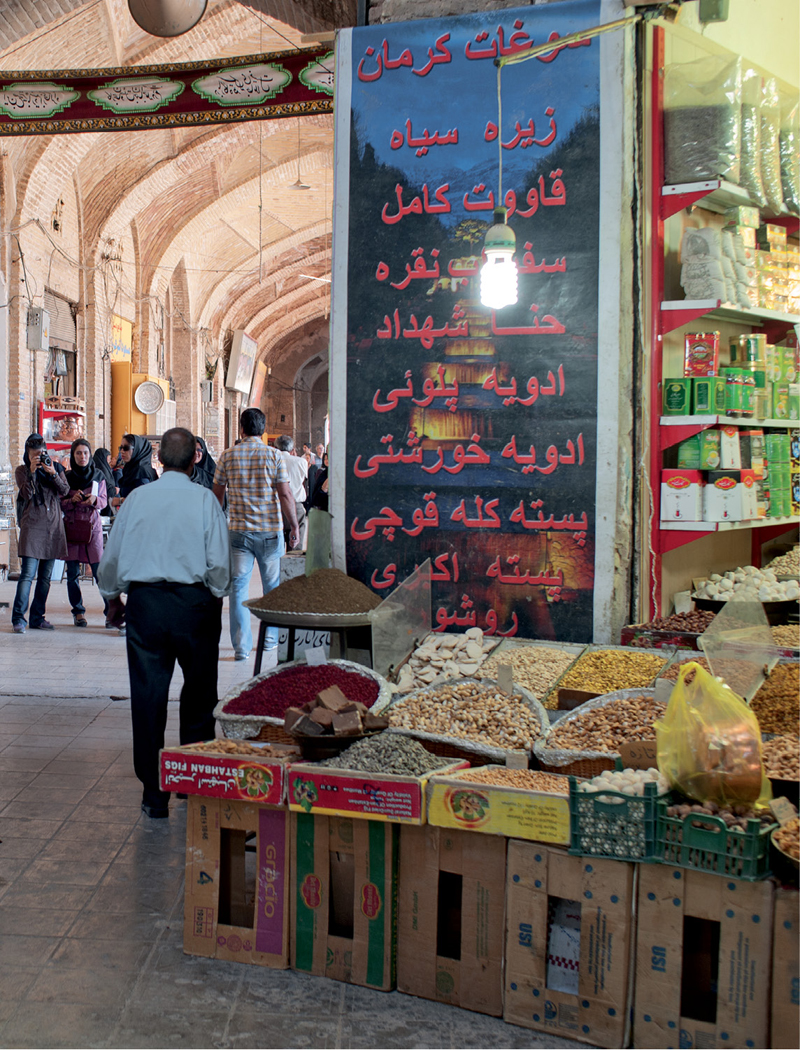
Kerman, Iran—A display of nuts and spices at the great Kerman bazaar.
Kurdish White Beans, shown with Kurdish Black Rice (see recipe), supple store-bought lavash, fresh cheese, and Svanetian Salt (see recipe).
There’s a whole category of easy stews called shley in Iraqi Kurdistan. Navy beans are the main ingredient in this particular shley, but I’ve also had it made with split peas. Like most shleys, this is flavored with a basic baharat (spice mix) of turmeric and cumin and cooks in a sauce flavored with a little tomato.
I learned the dish in Iraqi Kurdistan from a woman named Nermi. Nermi includes a dried lime in her shleys. It gives a distinctive and pleasingly intense aroma to the beans, but it can be omitted if you wish.
I like to serve this as I had it in Kurdistan, with plenty of bread and a generous bowl of fresh herb sprigs and greens—for example, trimmed scallions, flat-leaf parsley, and arugula or watercress. The other element on the table that goes beautifully with the beans is a salty cheese such as feta. Invite your guests to crumble the cheese onto their shley, or to wrap it in a flatbread with some of the fresh greens and eat it as an accompaniment to the beans.
Makes 3½ to 4 cups; serves 3 or 4
2 tablespoons sunflower or extra-virgin olive oil
¼ teaspoon turmeric
1 teaspoon ground cumin
3 cups cooked navy beans, with their liquid (see The Precooked Beans Habit), or about 2½ cups drained and rinsed canned beans plus ½ cup water
1 to 1½ cups water
½ cup canned crushed tomatoes
1 dried lime (optional)
1 teaspoon sea salt, or to taste
Place a heavy pot over medium heat, add the oil, and toss in the turmeric and cumin. Cook for a moment, until you see the turmeric fizzing a little in the oil. Add the beans, the water, and the tomatoes. If using the dried lime, prick it several times with the tip of a knife (be careful not to cut yourself, since it can ricochet if it’s very hard) and add it to the pot. Stir to mix, bring to a boil (press on the dried lime so it takes in liquid and starts to sink, rather than floating on the surface), and boil hard for a few minutes.
Add the salt (only ½ teaspoon if the beans are already seasoned), lower the heat to maintain a strong simmer, partially cover, and cook for 30 minutes. Taste and adjust the seasoning if necessary.
Serve hot or at room temperature.
Raya Taza, Armenia—In a Kurdish-Yazidi household, the matriarch, Gozeh, stashes her jars of preserved fruits safely under the shelves that hold the family’s sleeping pads and bedding.
The road from Yerevan climbs up out of the Arax River Valley and then up some more, leaving behind fertile lands with fruit trees and settled villages and eventually reaching spare upland rimmed with snow-topped mountains. In summertime, it is home to Kurdish shepherds who graze their herds of sheep and goats in the high pastures. In winter it’s austere and frigid, with snow and ice and wind.
On my first trip to Yerevan from Tbilisi, I passed through this landscape in a bus and regretted not being able to stop, because the small villages with their rare tufts of trees were beautiful in the slanting light of an October afternoon. Some days later, I traveled back up the road again in a car driven by Armin, a local driver. In the village of Raya Taza, we stopped to ask about the shepherds. “They came down from the mountains last week; it’s getting too cold up there,” we were told. And then we were invited in for tea.
Raya Taza is a Yazidi village. The people there are the descendants of Yazidis who lived in Turkey until 1915–16, when they had to flee. The genocide of the Armenians in that period was part of an attack on non-Turkish people, including the Assyrians (who are Christian) and the Yazidis, who follow their own distinctive faith and rituals (for more on the Yazidis, see Glossary).
The man who had invited us in was the son of Gozeh, the family matriarch. She sat in her large stone-walled kitchen and told us her story. She had married at fourteen and had had twelve children. Her husband, Alixan, had been in a nearby town when the 1988 Gyumri earthquake struck. He was killed by a falling building, one of hundreds of victims. Her youngest daughter, who brought us tea, had been married at thirteen.
Gozeh smiled with pleasure as she showed me her treasure: jars and jars of gleaming fruit stored under the stacked folded bedding in the main room (pictured here). The other time she smiled was when I told her that I had been to Lalish, the village of the “mother church” of the Yazidis, in Iraqi Kurdistan. “Ah, Lalish,” she said, her voice lifting.
Kidney beans and other speckled red-and-pink and kidney-shaped beans seem to be a favorite in Georgia. They are especially important on the fasting days of the Georgian church, when meat and dairy are forbidden.
But lobio dishes do not need the excuse of religion. They’re peasant stews, loaded with flavor, and usually eaten with Georgian corn breads. Special lobio restaurants outside Tbilisi, on the way to the ancient cathedral town of Mtskheta, serve customers at all times of year. It was at one of them that I first tasted lobio in 1989, on my first trip to Georgia. When I came back to the same place twenty-four years later with friends, a lot had changed. Georgia was an independent country; people felt freer, even if the economy was precarious; and there was a pride in being Georgian that could be openly expressed at last. But some things seemed the same, including the deeply satisfying lobio that we ate there.
Serve the beans with bread or Georgian Polenta (see recipe) along with fresh herbs. Put out ajika (see recipes here and here) if you have it, or Svanetian Salt (see recipe) as condiments.
Serves 4 as a main course, 6 to 8 as a side dish
4 cups cooked kidney beans, with their liquid (see The Precooked Beans Habit), plus 1 cup water, or 4 cups rinsed canned kidney beans plus 1½ cups water
2 bay leaves
¼ cup sunflower or extra-virgin olive oil
1½ cups chopped onions
1 red bell pepper, cored, seeded, and chopped (optional)
5 or 6 garlic cloves, minced
1 tablespoon powdered dried red chiles or 1 teaspoon cayenne
2 tablespoons Georgian Spice Blend (see recipe)
2 tablespoons tomato paste
2 tablespoons pomegranate molasses
¼ cup dry red wine (optional; see Note)
2 teaspoons sea salt, or to taste
Fresh flat-leaf parsley, coriander, or tarragon sprigs
Place the cooked beans and water in a pot with the bay leaves and bring to a boil, then reduce the heat to low.
Heat the oil in a wide cast-iron or other heavy skillet. Add the onions and pepper, if using, and cook for 5 minutes. Add the garlic and cook until the onions are translucent. Add the chiles, spice blend, and tomato paste and cook for a few minutes.
Add 1 cup of the beans and their liquid to the skillet and bring to a boil, then add the contents of the skillet back to the pot of beans. Add the pomegranate molasses, wine, if using, and salt and simmer for 5 to 10 minutes.
Serve garnished with the fresh herbs.
Note: I often add a splash of dry red wine to this and other bean dishes, though I have not seen Georgian cooks do it. The acidity and tannins bring out a meatiness in the beans, as does the pomegranate molasses.
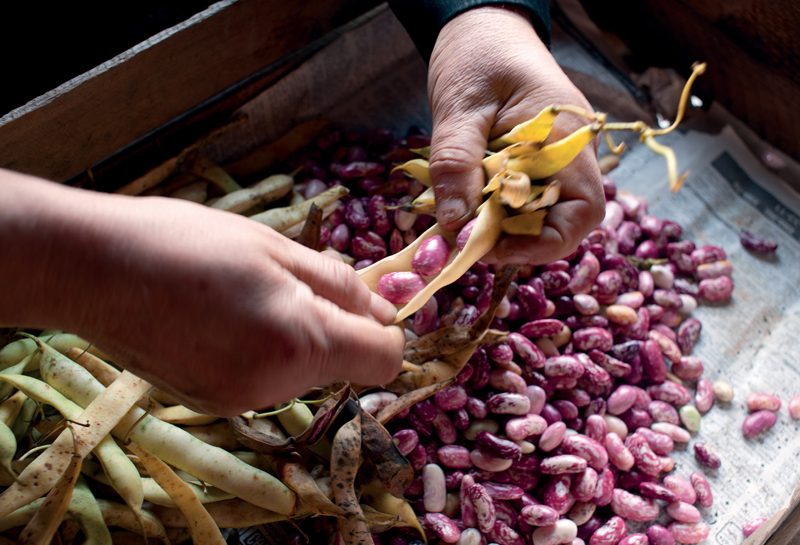
Tbilisi, Georgia—Shelling pink kidney beans at the market.